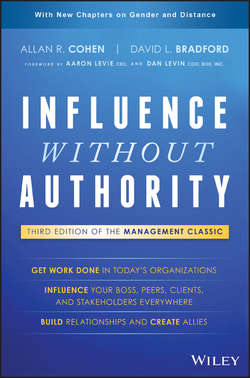Читать книгу Influence Without Authority - Cohen Allan R. - Страница 16
На сайте Литреса книга снята с продажи.
PART II
THE INFLUENCE MODEL
CHAPTER 2
THE INFLUENCE MODEL: TRADING WHAT THEY WANT FOR WHAT YOU'VE GOT (USING RECIPROCITY AND EXCHANGE)
Exchange: The Art of Give and Take That Permeates All Influence Tactics
ОглавлениеThere are numerous ways of categorizing influence behavior. You can influence people by methods such as rational persuasion, inspirational appeal, consultation, ingratiation, personal appeal, forming a coalition, or relentless pressure.6
Although it is tempting to think of these methods as separate tactics, we believe that exchange – trading something valued for what you want – is actually the basis for all. In every form of influence reciprocity is at work and something is exchanged.7 For example, rational persuasion works because the person sees the benefits of accepting the argument; inspirational appeal works because the person feels part of a cause or thinks that something good will result; ingratiation works because the person receives liking and closeness for willingness to be influenced, and so on. No tactic succeeds, however, if the receiver does not perceive some benefit, a payment in a valued “currency.” Having a wide repertoire of ways to influence others is valuable. You should use tactics that will work in a given situation; the underlying principle is giving something the other values for what you want or need (or withholding something the other values – or giving them something they don't want – if you don't get what you need).
This kind of reciprocity is constantly taking place in organizational life. People do things and get something in return (Table 2.1).
Reciprocity Naturally Takes Place in Organizational Life
Dr. Stanley Snyder, scientist, inventor, and entrepreneur, is an untenured senior scientist at a leading Midwestern university. As a maverick and self-described organizational outsider, Dr. Snyder learned to gain necessary influence through difficult experience. Dr. Snyder had long been an adjunct member of the biology department, a natural home for a PhD in molecular biology. There he had developed several patented technologies for the university and paid his own way through royalties and grants. However, he had been a thorn in the side of the assistant provost for research, who Dr. Snyder believed wanted any excuse to get rid of him.
The anthrax scare following 9/11/01 precipitated a confrontation. Dr. Snyder's work had principally involved biology, but the U.S. government needed a quick test for the presence of anthrax; a company approached Dr. Snyder to help develop it, and he “came to the rescue.” He worked with a colleague who had an anthrax strain in her research collection and could culture these bacteria. They rather quickly developed an inexpensive, practical way to detect anthrax. Dr. Snyder then went to the university provost to announce the good news and to help arrange a corporate license agreement, with royalties for the university. Instead of welcoming the news, the university administration, according to Dr. Snyder, “went ballistic,” prompted by the high anxiety over anthrax. He and his colleague were investigated by the university and then the local police and the FBI as if they were reckless scientists and criminals. They were placed on administrative leave (a very negative exchange!).
Dr. Snyder had liked working at the university with his colleagues and research collaborators. He did not wish to leave, and at first could only think of fighting the university. During this stressful period, a leading member of the physics department, Dr. Zelikoff, whom Dr. Snyder had previously helped with a patent application, met with him. As they discussed Snyder's employment problem, Dr. Zelikoff offered to explore having him join the physics department. A bit of an individualist himself, but skilled at working within the university organization, Dr. Zelikoff wanted to help both Dr. Snyder and the university resolve a difficult situation. He studied the policies and procedures and realized that he could invite Dr. Snyder (who would be self-funding anyway) to the department. Dr. Zelikoff would get a useful colleague and the department would receive a share of Dr. Snyder's royalties. Dr. Snyder would gain some protection and oversight as well as laboratory and office space. Resisting the efforts of the assistant provost for research to terminate Dr. Snyder, they worked out a deal with the provost (manager of the Assistant Provost) that benefitted Dr. Snyder, the department, and the university. Dr. Snyder is currently hard at work on applied research and new inventions, one of which is now a valuable commercial product producing large royalties for the university.
Table 2.1 Examples of Reciprocity at Work
6
Gary Yukl and J. Bruce Tracy, “Consequences of Influence Tactics Used with Subordinates, Peers, and the Boss,” Journal of Applied Psychology 77, no. 4 (1992): 525–35.
7
The concept of exchange is central to this book and will be given detailed treatment in subsequent chapters. We draw on some of the classic literature: George C. Homans, “Social Behavior as Exchange,” American Journal of Sociology 66 no. 6 (1958): 597–606; Peter M. Blau, Exchange and Power in Social Life (New York: John Wiley & Sons, 1964); Peter M. Blau, Bureaucracy in Modern Society (New York: Random House, 1956); and Peter M. Blau, The Dynamics of Bureaucracy 2nd ed. (Chicago: University of Chicago Press, 1963).
